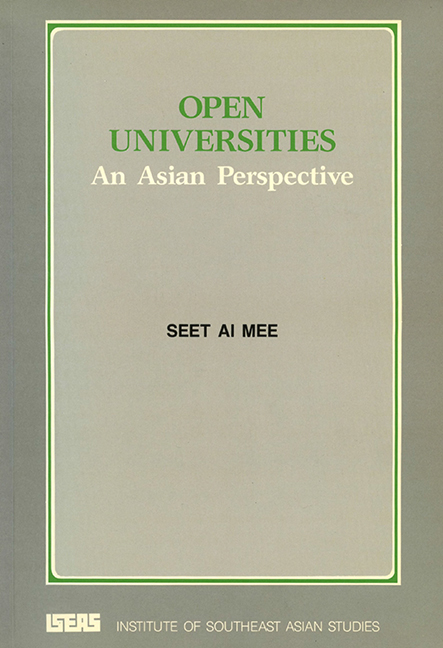Book contents
- Frontmatter
- Contents
- Acknowledgements
- I Introduction
- II Open Universities
- III The Quality of Distance Education
- IV Science and Technology Teaching
- V Continuing Professional Education
- VI Costs of Distance Education
- VII Concluding Remarks
- Notes
- Select Bibliography
- Abbreviations
- Member Institutions of the Association of Asian Open Universities
- THE AUTHOR
VI - Costs of Distance Education
Published online by Cambridge University Press: 21 October 2015
- Frontmatter
- Contents
- Acknowledgements
- I Introduction
- II Open Universities
- III The Quality of Distance Education
- IV Science and Technology Teaching
- V Continuing Professional Education
- VI Costs of Distance Education
- VII Concluding Remarks
- Notes
- Select Bibliography
- Abbreviations
- Member Institutions of the Association of Asian Open Universities
- THE AUTHOR
Summary
Costing of distance education is a complex task as open universities function in several modes — some single, some dual, some mixed. Indeed, the Comonwealth Secretariat addressed this issue in a report in 1986.
Whilst there is general consensus among economists that economies of scale are reaped by distance education systems, the structure of distance education cost systems is a problem. The majority of costing models are crude and many institutions tend to underestimate costs involved or have found it difficult to explain and justify the level of costs to their political masters, the governments or institutions which have set them up. The costing problems are bad enough with stand alone institutions providing government-subsidized undergraduate programmes. However, when continuing education and post-graduate programmes, which are often self-funding, are added to the existing programmes, the costing becomes even more complicated. When one has to deal with dual-mode teaching where a distance teaching unit is set up in conventional universities, the problems are exacerbated because no common measures exist to compare costs of conventional and distance education.
An important consideration of cost is how distance education is presented and what growth stage the institution has reached. Some generalizations can be made:
(a) in the initial stages, there is high capital investment in buildings and equipment;
(b) cost varies with the types of media used — the more media, the higher the cost; the more electronic media, the higher the cost;
(c) where country-specific materials have to be developed because of culture and language requirements, course development costs in the production years are high.
Therefore, different distance education institutions have different types of expenditure. Generally, however, lower costs and expanding educational opportunities are still the main advantages of distance education. Over the years, there have been changes in policies of financing distance education. One change in policy is in the movement from dual mode universities for distance education to “stand alones”.
- Type
- Chapter
- Information
- Open UniversitiesAn Asian Perspective, pp. 27 - 28Publisher: ISEAS–Yusof Ishak InstitutePrint publication year: 1992

